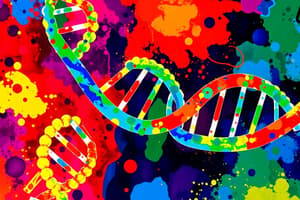Podcast
Questions and Answers
Which statement accurately describes the composition of lipids?
Which statement accurately describes the composition of lipids?
- Lipids consist of Carbon, Nitrogen, and Oxygen.
- Lipids are made of proteins and carbohydrates.
- Lipids are primarily composed of carbon and hydrogen. (correct)
- Lipids contain an equal ratio of hydrogen to oxygen.
What is a characteristic of triglycerides?
What is a characteristic of triglycerides?
- Create polymers for energy storage.
- Formed from two glycerol molecules and five fatty acids.
- Consist of one glycerol molecule and three fatty acids. (correct)
- Are solid at room temperature when unsaturated.
What role do phospholipids play in biological systems?
What role do phospholipids play in biological systems?
- Energy storage in the form of triglycerides.
- Serve as pigments for light absorption.
- Provide insulation for the nervous system.
- Act as structural components of cell membranes. (correct)
Which type of lipid is typically solid at room temperature?
Which type of lipid is typically solid at room temperature?
What is a defining feature of saturated fatty acids?
What is a defining feature of saturated fatty acids?
Which function is associated with steroids and modified fatty acids?
Which function is associated with steroids and modified fatty acids?
What defines lipids as non-polar hydrocarbons?
What defines lipids as non-polar hydrocarbons?
How do waxes function in biological organisms?
How do waxes function in biological organisms?
Which type of sugar is classified as a polymer?
Which type of sugar is classified as a polymer?
Which of the following describes a ketose?
Which of the following describes a ketose?
Which of the following is an example of a pentose?
Which of the following is an example of a pentose?
Structural isomers differ in which of the following aspects?
Structural isomers differ in which of the following aspects?
What is the molecular formula of monosaccharides generally represented as?
What is the molecular formula of monosaccharides generally represented as?
What is the primary structural difference between DNA and RNA?
What is the primary structural difference between DNA and RNA?
Which pair of bases are classified as purines in RNA?
Which pair of bases are classified as purines in RNA?
What holds the two strands of DNA together?
What holds the two strands of DNA together?
Why is starch more digestible than cellulose?
Why is starch more digestible than cellulose?
Which of the following correctly describes the base pairing in DNA?
Which of the following correctly describes the base pairing in DNA?
Which of the following sugars is found in RNA?
Which of the following sugars is found in RNA?
Which statement about RNA is incorrect?
Which statement about RNA is incorrect?
In what way do fats and carbohydrates differ in their energy provision?
In what way do fats and carbohydrates differ in their energy provision?
What distinguishes nucleotides from nucleosides?
What distinguishes nucleotides from nucleosides?
Which component is NOT found in both DNA and RNA?
Which component is NOT found in both DNA and RNA?
What direction do nucleic acids grow during the polymerization of nucleotides?
What direction do nucleic acids grow during the polymerization of nucleotides?
Which of the following statements about phosphodiester linkages is correct?
Which of the following statements about phosphodiester linkages is correct?
Which component is common to both DNA and RNA nucleotides?
Which component is common to both DNA and RNA nucleotides?
How many phosphate groups can be present in a nucleotide?
How many phosphate groups can be present in a nucleotide?
What is the primary role of nucleic acids?
What is the primary role of nucleic acids?
Which type of sugar is found in RNA?
Which type of sugar is found in RNA?
What is the defining characteristic of a homopolysaccharide?
What is the defining characteristic of a homopolysaccharide?
What type of glycosidic bond forms in cellulose compared to starch?
What type of glycosidic bond forms in cellulose compared to starch?
Which of the following statements about glycogen is true?
Which of the following statements about glycogen is true?
Which polysaccharide is notably part of the exoskeletons of insects?
Which polysaccharide is notably part of the exoskeletons of insects?
What is a common trait of both starch and glycogen?
What is a common trait of both starch and glycogen?
Flashcards are hidden until you start studying
Study Notes
Ribose and Nucleic Acids
- Ribose is the pentose sugar found in RNA, distinguishing it from deoxyribose in DNA.
- RNA is generally single-stranded, whereas DNA is double-stranded.
- RNA contains the nitrogen bases adenine (A), guanine (G), cytosine (C), and uracil (U); while DNA contains adenine (A), guanine (G), cytosine (C), and thymine (T).
- Base pairing occurs in DNA due to hydrogen bonding between purines and pyrimidines.
Differences Between DNA and RNA
- DNA: double-stranded with deoxyribose sugar and thymine as a nitrogen base.
- RNA: single-stranded with ribose sugar and uracil instead of thymine.
Nucleic Acids
- Nucleic acids are polymers, essential for storage and transmission of genetic information.
- Composed of nucleotides, which include a pentose sugar, phosphate group, and nitrogen-containing base.
Structure of Nucleotides
- Nucleotide consists of three components:
- Pentose sugar (ribose in RNA, deoxyribose in DNA).
- Phosphate group.
- Nitrogenous base.
- Nucleotides are linked by phosphodiester bonds, forming long chains that grow in the 5' to 3' direction.
Organic Molecules: Lipids
- Lipids include fats, oils, phospholipids, and steroids; mainly composed of carbon, hydrogen, and oxygen.
- Lipids have a higher ratio of hydrogen to oxygen (H:O > 2:1) and do not form polymers.
- Biological functions of lipids include energy storage, insulation, protective coatings, structure of cell membranes, and hormone regulation.
Fatty Acids
- Fatty acids consist of a long hydrocarbon chain with a carboxyl group (COOH).
- Can be saturated (no double bonds) or unsaturated (one or more double bonds).
Polysaccharides
- Polysaccharides serve as energy storage (e.g., starch and glycogen) and structural components (e.g., cellulose, chitin).
- Starch is a branched polymer, easily digestible, whereas cellulose is linear and indigestible by animals.
- Glycogen is similar to starch and serves as energy storage in animals.
Types of Simple Sugars
- Monosaccharides are the simplest sugars (e.g., glucose, ribose).
- They can be classified based on the number of carbon atoms: trioses (3), tetroses (4), pentoses (5), hexoses (6).
- Aldoses contain an aldehyde group, while ketoses contain a ketone group.
Chemical Basis of Life
- All elements consist of unique atoms, with a finite number essential for life.
- Chemical compounds are formed through bonding, and the same chemicals are found across all living organisms.
Studying That Suits You
Use AI to generate personalized quizzes and flashcards to suit your learning preferences.





